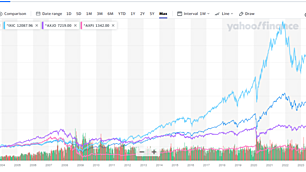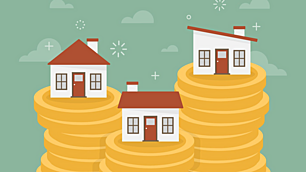Residential investment property is a sub-par way to grow your wealth – Part 1/2
I recently wrote a Livewire Markets piece on the potential pitfalls of exclusively (or almost exclusively) relying on either share price appreciation or franked dividends from Australian companies as the source of growth in your investment portfolio:

In this piece, I want to address the other often very large elephant in the Australian investment room.
Residential real estate.
In short – it is commonly a sub-par investment, relative to the readily available options. In this two-part wire, I’ll walk you through why. Part 2 will come next week.
To be very clear, I’m talking about buying an apartment, or a townhouse, or a house, maybe even a new one, borrowing to do that, doing functionally nothing to the property, and then renting it out. You go in believing that your outsized returns will come from income (lower than you think), and from price appreciation (you have better options).
If someone is a property developer, or is improving property, or is in commercial property, that’s potentially different. It should be noted that there’s a massive amount of risk to do those things, but there are pathways to making great returns in that arena. However, the overwhelming majority of Australians invested in real estate are invested in residential real estate as per the parameters noted in the paragraph above.
I am not insensitive to the massive emotional attachment that Australians have to real estate, but let’s talk about why. Unlike the US, we have a concentrated population with about two-thirds of the population in-and-around three big cities. When the global economy started to open up in the mid-90s and the early 2000s, wealthy people from all over the world started to buy real estate in desirable places, all over the world. Some of those desirable places are in Australia and because we concentrate in those three big cities so much, it had an outsized impact on prices in those three big cities. Now, lots more people were bidding on existing homes, and we couldn’t build new ones fast enough (we still can’t).
As a direct result, Australians felt the pressure to get invested in a home because if it turns out you can’t afford to buy in, say, Sydney, home prices were growing just as fast in Melbourne, and eventually in Brisbane, so you didn’t have many options.
In the US, for example, that’s not quite the case.
If you’re from New York and you’re in finance but for some reason can’t (or don’t want to) afford a home in New York, you can move to Chicago or to Charlotte, two other large finance centres in the US, pay a fraction of the cost for housing and schools and taxes and food, and still have a great job.
We don’t have that situation and it’s a big reason why Sydney and Melbourne drive the national home market – because many of the highest paying jobs are in those two cities. I would posit that the emotional attachment that Australians feel towards real estate is borne out of necessity, it is not a considered and calculated affection.
And not to burst anyone’s bubble, it's not just the "Australian Dream" - buying a home in the US is also called the “American Dream”.
With that out of the way, allow me, if you will, to explain what I mean by “it is commonly a sub-par investment”, because I don’t mean you won’t make any money. But I do mean that you have significant hurdles to get over that likely make residential real estate a less-than-optimal growth investment.
To reiterate, I am specifically covering buying residential real estate with a view to levering it up, renting it out, and growing your wealth. It’s unlikely to be your best option and there are three main reasons I’ll highlight in this piece. There are more reasons than that, truthfully, but let’s focus on what I think are the big three. The first (and I think biggest) reason comes this week, the other two will come next week.
Reason 1 - Costs
Costs are always ignored, it’s the biggest reason people overstate their real estate returns. I’ll give you a perfect example.
I spoke at a seminar semi-recently where I was covering a macro set of topics when someone asked me a question about investment options and within that answer, I suggested that real estate is actually a limited growth vehicle.
Then a gentleman stood up. Literally stood up. Here we go…
He proceeded to inform me that his son had purchased a very expensive home in a very nice part of Brisbane for $5,950,000 and just 5 years later, he sold it for $8,000,000 after only spending $200,000 to spruce it up. He asserted his son made almost $2,000,000 in just 5 years and that residential real estate is genuinely a growth investment.
A few things.
Firstly, everyone needs somewhere to live and if applicable, to raise their family. I’m not saying don’t buy residential real estate, but what I am saying is don’t view that purchase as a growth investment.
It isn’t, it’s your home.
Secondly, this gentleman ignored ALL of the costs. When I started calculating the return, he was unhappy with me when I highlighted all of this:
Cost $5,950,000
Stamp Duty $300,000
Rates and Insurance $50,000 (over 5 years)
Renovation $200,000
Real Estate Agent $150,000
Sale Proceeds $8,000,000
The real cost of this home is $6,275,000, and the proceeds are only $7,625,000. That’s allocating the stamp duty and half the rates and insurance to the cost, and then deducting the other half of the rates and insurance from the sale proceeds, as well as deducting the real estate agent fees, and the renovation. Now this home only made $1,350,000 over 5 years and that’s an annual compound growth rate of 3.97%.
Read that again – this supposedly amazing investment made just 3.97% per year.
I’ve done the same analysis on my childhood home in Frenchs Forest on the northern beaches of Sydney, as well as the home that my parents downsized into in Mona Vale, in the far northern beaches of Sydney.
Same result, both times. In fact, I’ve done this exercise many, many times and it works out the same pretty much every single time.
And this applies to a very large majority of residential real estate investments across Australia. Not all of them, I know, but once you account for the massive and fixed expenses to buy real estate, to hold real estate, and to then sell real estate, the returns are significantly lower than you might imagine.
Although again, if you’re developing or improving real estate, this likely doesn’t apply. But almost no one is doing that – it’s buy, lever, hold, and maybe sell.
Next week, in the second part of this wire, I’ll go over the other two big (and very often ignored) risks for residential real estate investors.
In the meantime, good luck out there.

5 topics

